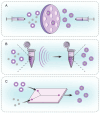Cell Membrane-Coated Biomimetic Nanoparticles in Cancer Treatment
- PMID: 38675192
- PMCID: PMC11055162
- DOI: 10.3390/pharmaceutics16040531
Cell Membrane-Coated Biomimetic Nanoparticles in Cancer Treatment
Abstract
Nanoparticle-based drug delivery systems hold promise for cancer treatment by enhancing the solubility and stability of anti-tumor drugs. Nonetheless, the challenges of inadequate targeting and limited biocompatibility persist. In recent years, cell membrane nano-biomimetic drug delivery systems have emerged as a focal point of research and development, due to their exceptional traits, including precise targeting, low toxicity, and good biocompatibility. This review outlines the categorization and advantages of cell membrane bionic nano-delivery systems, provides an introduction to preparation methods, and assesses their applications in cancer treatment, including chemotherapy, gene therapy, immunotherapy, photodynamic therapy, photothermal therapy, and combination therapy. Notably, the review delves into the challenges in the application of various cell membrane bionic nano-delivery systems and identifies opportunities for future advancement. Embracing cell membrane-coated biomimetic nanoparticles presents a novel and unparalleled avenue for personalized tumor therapy.
Keywords: biomimetic; cell membrane-coated nanoparticles; drug delivery; tumor targeting.
Conflict of interest statement
The authors declare no conflicts of interest.
Figures

















Similar articles
-
Biomimetic Cell Membrane-Coated Nanoparticles for Cancer Theranostics.ChemMedChem. 2024 Nov 18;19(22):e202400410. doi: 10.1002/cmdc.202400410. Epub 2024 Sep 12. ChemMedChem. 2024. PMID: 39264862 Review.
-
Recent advances in cancer cell bionic nanoparticles for tumour therapy.J Drug Target. 2023 Dec;31(10):1065-1080. doi: 10.1080/1061186X.2023.2283838. Epub 2023 Nov 29. J Drug Target. 2023. PMID: 37962304 Review.
-
The Emerging Role of Cell Membrane-coated Nanomaterials in Cancer Therapy.Curr Pharm Des. 2024 Mar 1. doi: 10.2174/0113816128295414240221063434. Online ahead of print. Curr Pharm Des. 2024. PMID: 38441015
-
Erythrocyte-biomimetic nanosystems to improve antitumor effects of paclitaxel on epithelial cancers.J Control Release. 2022 May;345:744-754. doi: 10.1016/j.jconrel.2022.03.060. Epub 2022 Apr 2. J Control Release. 2022. PMID: 35381274
-
Biomimetic theranostic nanoparticles for effective anticancer therapy and MRI imaging.J Photochem Photobiol B. 2023 Dec;249:112813. doi: 10.1016/j.jphotobiol.2023.112813. Epub 2023 Nov 8. J Photochem Photobiol B. 2023. PMID: 37977004
Cited by
-
IL-15 functionalized biomimetic hybrid mRNA vaccine for enhanced NSCLC immunotherapy via synergistic activation of T cells and NK cells.Mater Today Bio. 2025 May 27;32:101914. doi: 10.1016/j.mtbio.2025.101914. eCollection 2025 Jun. Mater Today Bio. 2025. PMID: 40520563 Free PMC article.
-
Bioinspired Nanoplatforms: Polydopamine and Exosomes for Targeted Antimicrobial Therapy.Polymers (Basel). 2025 Jun 16;17(12):1670. doi: 10.3390/polym17121670. Polymers (Basel). 2025. PMID: 40574198 Free PMC article. Review.
-
Biomembrane-coated nanosystems as next-generation delivery systems for the treatment of gastrointestinal cancers.Bioeng Transl Med. 2025 Feb 26;10(4):e70006. doi: 10.1002/btm2.70006. eCollection 2025 Jul. Bioeng Transl Med. 2025. PMID: 40708975 Free PMC article. Review.
-
Neutrophil/monocyte-targeted dual-ligands modified liposomes delivering puerarin for ischemia stroke treatment.Mater Today Bio. 2025 Jul 12;33:102077. doi: 10.1016/j.mtbio.2025.102077. eCollection 2025 Aug. Mater Today Bio. 2025. PMID: 40697323 Free PMC article.
-
Recent advances in biomimetic nanodelivery systems for cancer Immunotherapy.Mater Today Bio. 2025 Apr 5;32:101726. doi: 10.1016/j.mtbio.2025.101726. eCollection 2025 Jun. Mater Today Bio. 2025. PMID: 40270890 Free PMC article. Review.
References
Publication types
Grants and funding
- 81872220/National Natural Science Foundation of China
- 81703437/National Natural Science Foundation of China
- LTGY24H160007/Basic Public Welfare Research Project of Zhejiang Province
- LGF18H160034/Basic Public Welfare Research Project of Zhejiang Province
- LGF20H300012/Basic Public Welfare Research Project of Zhejiang Province
LinkOut - more resources
Full Text Sources

